Heaven Sent
Todd Haynes's 2002 film Far From Heaven is an exquisitely crafted melodrama set in the 1950s that was released at the beginning of the George W. Bush presidency. Richly ambivalent, the film pays homage to Douglas Sirk's Technicolor 1950s melodramas such as All That Heaven Allows and Imitation of Life (which would serve as an apt title for all of Haynes' films), while updating its politics for the present day, dealing openly with the repression, and oppression, of a woman, a closeted gay man, and an African American.
The film was a collaboration between three remarkable talents—writer-director Haynes, production designer Mark Friedberg, and costume designer Sandy Powell—and its intensely detailed and complex coordination of color is highlighted in the exhibition PERSOL MAGNIFICENT OBSESSIONS: thirty stories of craftsmanship in film, curated by Michael Connor, and on view at Museum of the Moving Image through August 19, 2012. In conjunction with the exhibition, Haynes, Friedberg, and Powell spoke at the Museum following a screening of the film last month.
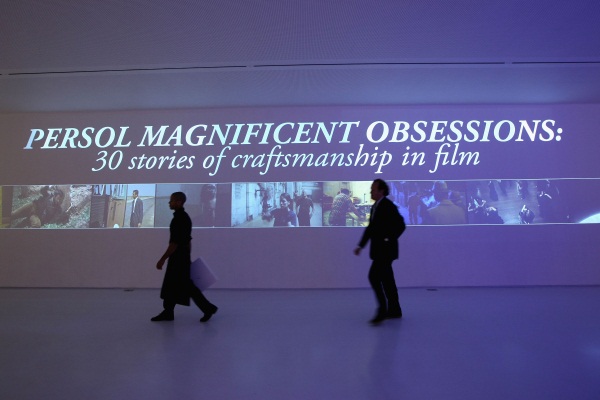
Opening of the exhibition Persol Magnificent Obsessions at the Museum of the Moving Image
DAVID SCHWARTZ: We have a collaborative dream team here tonight. I first want to introduce Sandy Powell, who I met yesterday. I told her I realized every time I see her, she's receiving an Academy Award, so we should probably give her one tonight. She's been nominated 10 times for Oscars; she's won three times, for Shakespeare in Love, The Aviator, and Young Victoria. Her other credits include The Crying Game; Velvet Goldmine, for Todd; The End of an Affair, also with Julianne Moore. And luckily for us, she has been collaborating with Martin Scorsese recently. She did the costumes for Gangs of New York, The Departed, The Aviator, Shutter Island, Hugo, and is working on the new film right now, so she's in New York. Please welcome Sandy Powell.
And Mark Friedberg, who we did a master class with a few weeks ago, works for so many of the best directors: Wes Anderson, on The Darjeeling Limited and The Life Aquatic with Steve Zissou. He did Across the Universe with Julie Taymor; Pollock with Ed Harris; The Ice Storm and Ride with the Devil with Ang Lee; Broken Flowers for Jim Jarmusch; Synecdoche, New York for Charlie Kaufman; and he's working on Noah right now for Darren Aronofsky. He actually just came in from Iceland, where they're doing locations for Noah, and we're very pleased that he's with us. So please welcome Mark Friedberg.
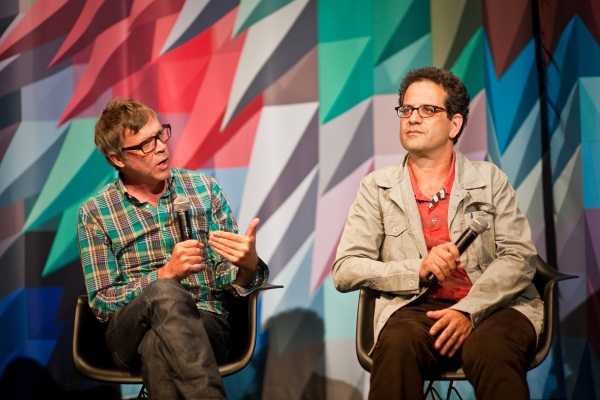
Todd Haynes and Mark Friedberg at the Museum of the Moving Image
And it's very special for me to be able to introduce Todd Haynes, because he was here in 1988, when we showed Superstar. And that was a time when you could show Superstar in glorious 16mm. Of course, you know his credits: Poison, Safe, Velvet Goldmine, Far From Heaven, I'm Not There, Mildred Pierce, which has become our annual Mother's Day film. And that's also designed by Mark, an incredible piece of work. So we're thrilled that he's back with us today. Please welcome Todd Haynes.
I'm going to read a quote from Todd's director's statement for the film. He writes, "In Far From Heaven, the love and pain depicted is almost too big for any single character to contain. So it spills into the music, the wardrobe and décor, the colors and shadows onscreen; the style as expression, to be spread into nonverbal arenas, displacing the desire and villainy of the characters onto, literally, the walls and the clothes that they inhabit." I think that really captures a lot about the film, that it really is conceived in these visual terms. Todd, could you talk about how you conceived the film?
TODD HAYNES: Well, this was a real extraordinary production, full of amazing memories of working with these two extraordinary people and Ed Lachman and Elmer Bernstein, who did the score. And that's not even getting into the amazing actors. It was a labor of love, because it was my own humbling sort of tutorial, looking at the great work of Douglas Sirk and some of the work of Max Ophüls, that also felt relevant to the storytelling; and really paying homage to this pretty unique period of mid-century Hollywood studio filmmaking that brought the whole tradition of the maternal melodrama, domestic melodrama, to a level of technical brilliance and complexity, let alone dramatic complexity that's always been part of this genre. And the amazing thing about the genre, and the thing that allows for the visual language and the oral language—melodrama means music and drama, literally—is that it's often about—and I think this is best epitomized in the best films of Douglas Sirk; that was definitely my inspiration.
The subjects are really limited, ordinary people. Not heroic people. They are people who you might call victims of their respective societies who don't always have the wherewithal to handle the conflicts that they encounter in their lives. And the kinds of conflicts that they encounter are the kinds we all encounter in life. They're about family and love and loss and infidelity. But these are people with limitations. Again, like us. And so they can't always articulate what they are experiencing. There are articles about characters in melodrama that talk about them always being in a state of semi-astonishment about the fates that they're encountering as they unfold. You see this in Jane Wyman or Lana Turner or some of the famous Sirk heroines. But that limitation of being able to articulate and master their problems means that it provides and makes necessary the whole cinematic language to fill in for those limitations—as opposed to often what we experience in movies, where the meaning is quadrupled by verbiage, by heroic characters who are in control of the narrative trajectory, and then followed up with music and image, and you're like, "Yeah, I get it, I get it, I get it." This really leaves these spaces, where music, color, décor, costume, gesture, camera have a role to play, and a necessary role, sometimes, to communicate things characters aren't capable of. And sometimes to contradict what they are saying and to create a kind of counter language. These decors are often claustrophobic and overwhelming, and in some ways, belittle the subjects themselves. So in all of these ways, it enables people like myself to bring people like these guys onboard and make use of their amazing abilities.
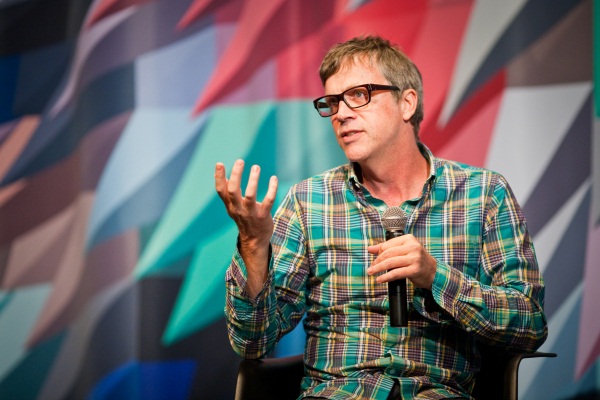
Todd Haynes at the Museum of the Moving Image
SCHWARTZ: Here, you talk about what the feelings were and what your intention was with the drama. I'll read one more quote; it's the last quote I have. But I wanted to do this because it's me quoting you, quoting Rainer Werner Fassbinder, quoting Douglas Sirk, which seems appropriate for this occasion. And the quote is, "You can't make films about things. You can only make films with things, with people, with light, with flowers, with mirrors, with blood." Meaning that everything you're talking about has to be physicalized. So if you could talk about that process: let's start maybe with this idea of your color scheme, because I understand that you had long conversations, the three of you—I guess with Ed [Lachman, the cinematographer]—about color and how you would approach each scene.
HAYNES: Well, it started with Sirk, who's known for these mid-century masterpieces—Written on the Wind, All That Heaven Allows, Magnificent Obsession, Imitation of Life that are known for their use of color and for a use of wider-angle lenses that keep deep focus and create a kind of enamel, hard-edged harshness, almost, to the color palette. This was an opportunity for us to make color a seminal part of our aesthetic discussion and the way that we really conceptualized these spaces that the characters inhabit and the changes and the contradictory spaces. A lot of the film is about bound, very intensely zoned spaces that are transgressed or trespassed by the characters. I started by writing the script, but then spent time with scenes and just using Pantone color swatches and creating kind of a color temperature.
Probably the seminal film we looked at was All That Heaven Allows, from 1956. And in that case, unlike Written on the Wind, which has a kind of more primary color palette—All That Heaven Allows has this beautiful autumnal, but also complementary palette, where you see elements of warm and cool in almost every frame of the film. It gives a kind of intuitive resonance to the conflicting emotions and the irreconcilable conflicts in the story. We really took that as a kind of liberty to talk about complementary colors and a mixing of temperature—emotional and narrative temperature, I guess. We started with these color swatches that were almost designed scene by scene.
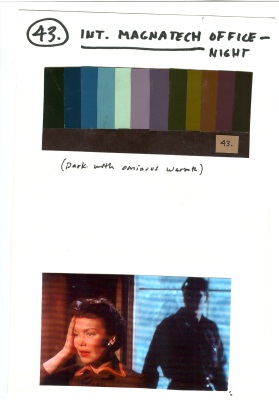
Color chart for scene 43 of Far From Heaven with still reference from All That Heaven Allows
MARK FRIEDBERG: We actually translated the script into color. There was a color version of the script. It was almost a scoring, in a way, a scoring session.
SCHWARTZ: Yeah, and again, you can see these swatches upstairs. Sandy, can you talk I about your early discussions about this film? Because you had worked on Todd's previous film, Velvet Goldmine, which was so different.
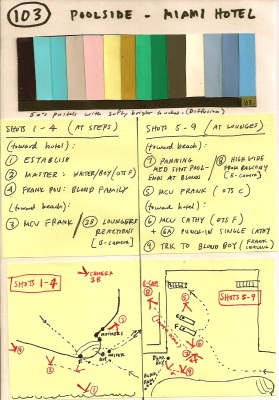
Color chart for scene 103 of Far From Heaven with drawings by Todd Haynes
SANDY POWELL: Well, the subject matter was different, but I think the process was similar. I mean, we had long, intense meetings during Velvet Goldmine, and Far From Heaven started out in the same way. But the meetings I remember most are the ones with Todd, Mark, and Ed. And it went on for days, actually. We had long weekends, where I remember we looked through All That Heaven Allows, scene by scene, as well as going through our script with the Pantone colors, and talked and talked. And what I did with the colors, I did a similar thing with the fabrics. I bought lots of fabric swatches, laid them out on a table, and I had them there and—I think you used the word intuitive, and I think it was an intuitive decision, as to which colors to use where, knowing what Todd's color choices were. But it wasn't ever anything like, "Oh, I'm going to make the dress pink because that's the pink he's got in his swatch." It just came together instinctively, in a way. I worked in the same way, with the colors just spread out on a table in front of me.
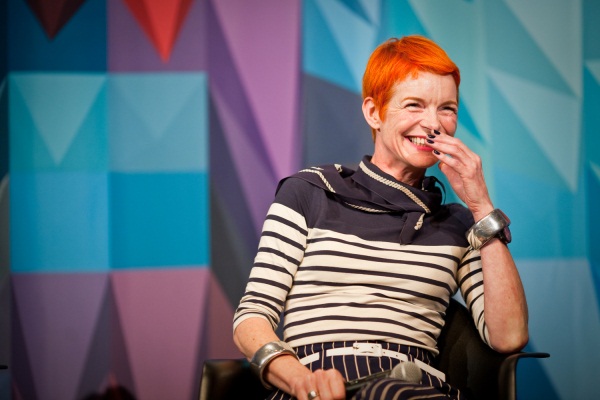
Sandy Powell at the Museum of the Moving Image
SCHWARTZ: And Mark, what could you say about this process? What was it like?
FRIEDBERG: I actually met Todd in fine art class in college, and so to work with a director who had such an understanding of what you can do with color. It wasn't just that this scene would be this color and this would be that; but it was more that the costume might be doing this and the wall might be doing that, but the light might be counteracting it and all that. That created a dynamic. Because the characters can never really say what they feel or feel what they say, it's the vibration between inherently oppositional things that go together beautifully, that allowed them to, in a way, help us to help them figure out what they were feeling, or to allow it out into the world.
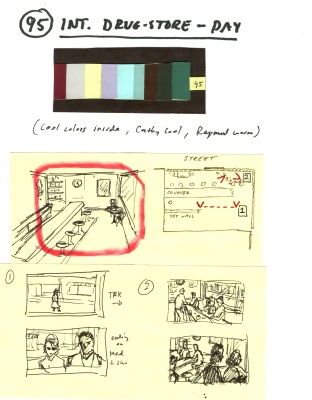
Color chart for scene 95 of Far From Heaven with drawings by Todd Haynes
SCHWARTZ: And how did you talk about the tone of the film? It's a film which at first, when you hear the idea of it, it seems like it's going to be ironic or postmodern in a way. And I guess more and more over time, as you revisit the film, you realize the emotional power of it.
HAYNES: I just watched it a couple days ago, preparing for this evening. I hadn't seen it in many years. And I found a director's statement—because I had to go through all this old stuff for the exhibition—where I did say, in some sort of a statement that was part of the script, that I think you guys all got, was that it was in the great tradition of Sirk and so forth. But I was self-conscious about doing it when we were doing it. And this was at the very beginning of George W. Bush's first year. And it was before 9/11. In fact, 9/11 happened while we were in preproduction on Far From Heaven in New York, when we were actually driving to ground zero. We were driving to 80 Center Street.
There was at least a mirroring or something about the era of complacent consumerist culture that we were entering with Bush, that felt relevant to the 1950s in America. Or at least something that there could be a dialog between the two, in this film. But that said, I think somewhere in that statement I said we would play this straight. You know, we would take these stylistic traditions with a great deal of love and care, and not be above them.
FRIEDBERG: We would wear them.
HAYNES: We would wear them. We would try to learn from them and emulate them as best as possible. Now, I knew at some level that was a tremendous risk, that this could be alienating. Melodrama has a way of pushing you out, and then secretly sort of sucking you back in at the same time. This has been true, I think, for melodrama from the beginning, even in its origins in 19th century literature, in European canons of literature, popular literature, because it was always there to kind of expose social contradictions and limitations; but it was also a popular art form. You know, a mass form. So it had these almost diametrically opposed instincts going on at the same time. And I think you feel a contradiction in them, and it's even why Fassbinder said, "They leave you feeling unsatisfied," in an interesting way.
SCHWARTZ: Could either of you, Sandy or Mark, talk specifically about the sort of materials you were working with? You were using an interesting mix of locations and sets. The train station is Yonkers—which has never looked so good, that train station. So you found some great locations to work with, but also were building sets.
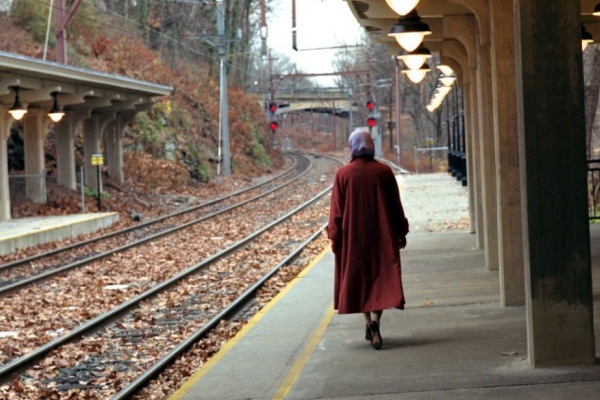
Julianne Moore in Far From Heaven
FRIEDBERG: The hard part, and the exciting part, was that you wanted the sets to look like sets. And so we were sort of trying to make our locations feel like sets, in ways. And that's part of Bush's America was the kind of artifice that we live in. And so both saying that we've made this, this isn't real; and at the same time, there's so much real that you're feeling, because you have to live this way.
It took me a long time to try and figure out what that meant. You know, we spend so much time trying to make our sets look like they're real, so that the characters can exist in them. And if you notice that they're sets, you've failed horribly, because the set is a background and it should be pushing the story forward and allowing it. And here, the set gets there about 10 minutes before the actor does sometimes, and the colors are shiny and—it took me a little while to understand that. Of course, I haven't quite gotten over it now. I like it when the sets get there early. That was nice.
POWELL: I just noticed the same thing with the costumes. Normally, when you make a costume for an actor, once you'd made it, you'd work on it to make it look like it'd been worn, and look a bit old and look real. And I actually noticed that, my God, everything looks brand new and crisp and fresh and bright.Which is not normally what I do. And I think it must've been the same thing, like, everything's fresh off the press.
FRIEDBERG: Yeah. We were shooting in autumn, and still painting the leaves to make them more colorful.
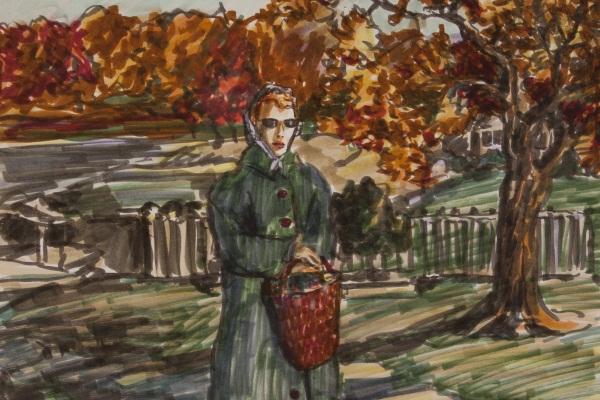
Drawing by Todd Haynes that served as inspiration for the character of Cathy Whitaker
SCHWARTZ: Could you talk about the costumes for Julianne Moore's character? Because there are so many costume changes, and this is a character where you have to feel this inner life and depth to her, that she can't quite express verbally. It's one of the great things about the script—the characters are limited in what they can express, but you know there's a lot going on underneath. So a lot of this comes through in her costumes.
POWELL: We sort of tell the story through the costumes, without being as obvious. I wouldn't sort of give her a sad dress because she was feeling sad. But somehow, you use the color and the tone of what she's wearing, to help convey the feeling of the entire scene, really, and what's going on.
FRIEDBERG: Wasn't there some discussion about the shape of her costumes? Because Eleanor wears the more pencil skirt silhouette—
POWELL: Yeah. But the silhouette that Julianne has is slightly old-fashioned for where we were then. It was a more conservative, more old-fashioned look. Which is why at the end, her very last outfit is the straightest silhouette. That was about her sort of moving on to a new life...and sort of getting rid of the old life and the old-fashioned full skirts.
FRIEDBERG: But similarly, the way we conceived of the set, because it was the first time that I really was ever allowed to, or made it necessary, to have a set built for such a huge part of this film, which was the house. I knew I wanted to emulate these high-low angles and these sort of places where characters would be looking down or up to each other, and creating those tensions, almost those little pools of conflict—especially in the party scene, with Frank. And again, it was constructing the shape to suit the dramatic needs of the film, which was an amazing opportunity that we had together.
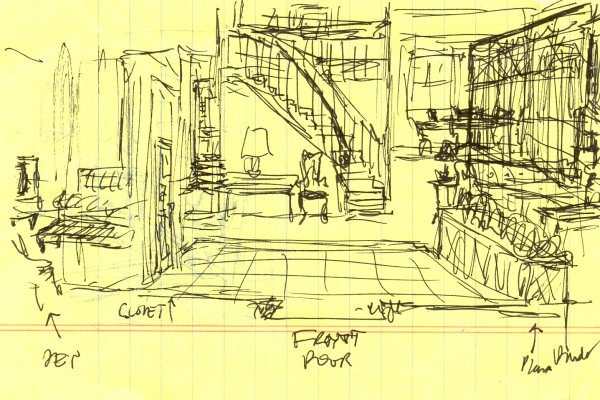
Drawing by Todd Haynes of the interior of the Whitakers' house from Far From Heaven
SCHWARTZ: I imagine that on most films, the director, costume designer, and production designer might not have to work so closely together every step of the way. It feels with this one that no detail can happen without an intense conversation involving all of you. It's so exquisitely detailed and meticulous.
FRIEDBERG: You know, when you do reality, your life has got layers and layers and layers of what you have. The things behind the books, and in this case, the details were what we were seeing. They were particular. They were placed very self-consciously. So they had to be considered; they couldn't be a random thing, just thrown there, because it was only one or two or three. They all, in a way, had to keep the story moving; but in another way, not necessarily be totally about where that character comes from all the time, which is often the case. You know, a lot of times with the setting, you are telling the story of that person up to that moment: the way they've lived, what's in their room, what's around them. And it wasn't so much that way here; it was more about almost sometimes setting them apart from their own world, so that they almost didn't feel completely comfortable.
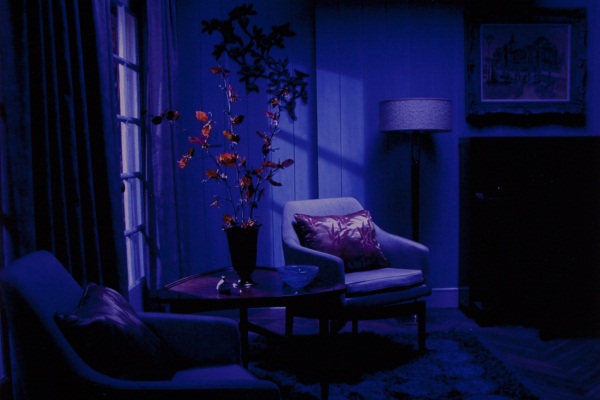
Far From Heaven
SCHWARTZ: Okay, let's open it up for questions.
QUESTIONER: I just want to say first and foremost, I'm a big—I don't know if it's cool to say fan, or admirer of your work.
HAYNES: Thank you.
QUESTIONER: Looking at Velvet Goldmine, and the way you dealt with the male gays in that film, and then you look at this film, is there ever a moment where you look at the Dennis Quaid character as you're developing him and did you ever want to give him more of a role than, like, he's the victim of the heart who wants what the heart wants and nothing more? As opposed to, he's the racist, closet-gay guy, who just wants what he wants and he's going to get a divorce.
HAYNES: I don't know if people heard the question. It's about whether the character of Frank, the Dennis Quaid character in Far From Heaven, as opposed to the way gay identity is explored in Velvet Goldmine, if I ever wanted to give him more of a central role, I assume. And I didn't. I felt from the very beginning there was something about the domestic drama being so rooted in the female character—although all three characters are complexly intertwined in this story, and I wanted it to have that kind of diagrammatic interdependency, where each person, just in pursuing their desires, casts pain on the other, in a tight web, you know, where events are acted upon people. There's no villain, you know? People are just being human and trying to figure out their lives. But it ends up indicting and affecting and hurting the others around them. But I still felt that it was almost most interesting to see—it didn't take a liberationist position, this film. What it's saying, I guess, is that the woman—although these three kinds of oppressions can be compared, that in a way, the woman is on the bottom rung, and has to maintain the dignity and the continuity of the family and that institution; and in a way, has to surrender the most and give up the most. And ironically, in the 1950s, a gay man, who can hide, who can disappear or make his desires selectively visible, has ultimately more freedom to maneuver. And that the black man, who's so overly visible as black, is over-interpreted. And Frank has hiding places that Raymond and Cathy don't. But I felt that I wanted to show that unique burden that the woman has, and the maybe extra burden of sacrifice that she has to show.
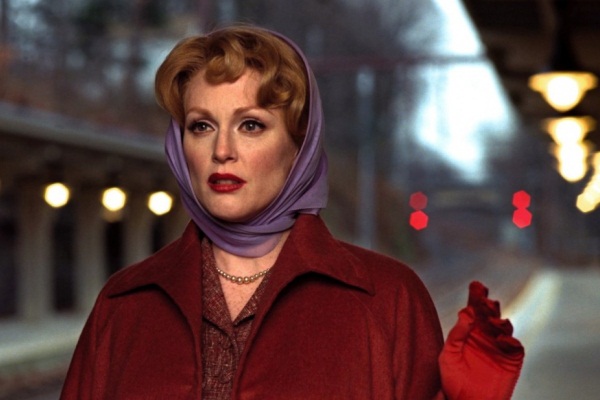
Julianne Moore in Far From Heaven
SCHWARTZ: Could I just ask—two decisions that you made that are interesting in this regard. One, I think you said that you had thought about having a more explicit sex scene, when she discovers Frank in the office, kissing the man. But you had thought about maybe doing a more explicit sex scene and decided not to. And then also, the only moment, I think, in the film when there's obscenity is when Frank says, you know, "I just want to fucking get it over with."
HAYNES: Right.
SCHWARTZ: And it's a powerful moment, because it's the only time in the film. And then her reaction to that. Like, she's so shocked.
HAYNES: Yeah, yeah. It was a matter of extremes, I guess. Or the whole thing was a matter of balancing. It's such a tightly wound generic tradition and specific story and kinds of characters, obviously. And even with the constraints of melodrama itself and adhering to the '50s traditions, these were also people who wouldn't be able to express themselves very freely. And for someone like Frank to undergo what he's undergoing is radical, and to even say "fuck" is radical, and to kiss a man is radical. So all of these things had measures of degree that had to be balanced against others.
FRIEDBERG: And they almost seem stronger, for the restraint. If you just go out and do it...then okay, you've done it. The fact that everything was kind of held...makes it something that we can relate to, rather than just telling it to us.
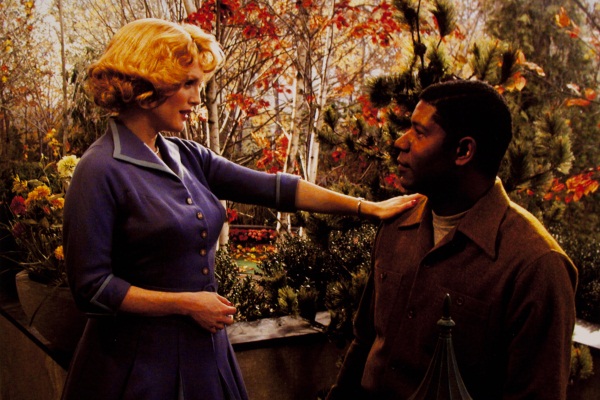
Julianne Moore and Dennis Haysbert in Far From Heaven
HAYNES: Right. Yeah. And then, you know, Raymond kissing Cathy's hand becomes as strong a thing as Dennis kissing that guy, you know.
QUESTIONER: What was it like working with child actors?
HAYNES: They were fantastic kids to work with. What was tricky about this film, and it's sort of inherent in Sirk, is that children are often little monsters. They're little emblems of patriarchal belief in oppressive feelings, right? So there's no real sentimentality for the kids. Even Mad Men shows so much more sympathy, I think, in the way kids are dealt with, than Sirk does and the way we tried to follow in that tradition here. So it's really tricky. Like, you see that moment with the son, after you hear about Raymond's daughter getting hurt. And he's like, you know, "Dad!" He's kind of excited about this horrible act of violence that occurred in school. And then he's like, "Well, why don't you turn the TV set on, Skip?" And he's like, "Sure, Dad." And it's like you sense this weird dismissal of the severity of that event that aligns the men with each other, and you see a link in that. You see the femininity in issues of how a woman is supposed to be, also shared among mother and daughter, in that early scene in the mirror, as well.
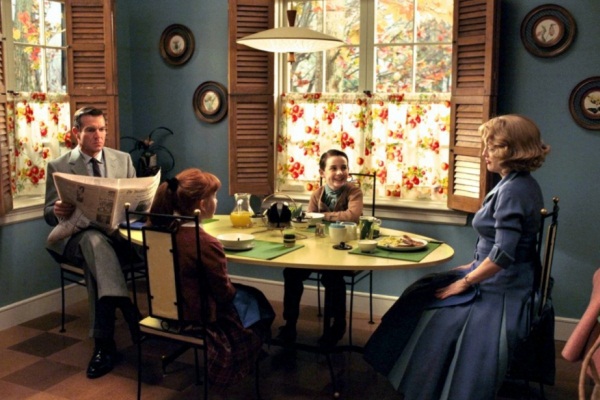
Dennis Quaid and Julianne Moore in Far From Heaven
QUESTIONER: You've moved into television by doing Mildred Pierce. But would it be hard to do a film like this now, as a theatrical film?
HAYNES: Although noirs continue to be made and westerns continue to be made, genres associated with women, like domestic dramas, are denigrated and they're looked down upon. And male-associated dramas maintain a currency in contemporary culture, in ways that films where female audiences are associated, don't. It was a risk. It was a complete and total risk. And I consider it as much of an experiment as any of my other films. But what was so remarkable and surprising, I think, to everybody involved, is that this became my crossover movie. This is the most successful movie that I've made, in terms of critical acclaim, in that it really crossed over to a wider audience. It made me feel so thrilled, not just about the film and all the great people I got to work with on it, but that this genre works and continues to both critique American culture and push you out enough to make you think about all those things, but then draw you back in emotionally, at levels that you really feel. And I remember hearing the story about a woman who worked in the film business, who had been meaning to see Far From Heaven, didn't get around to it; had a screener, finally watched the screener; had a three-year-old child who was sleeping on her lap, when she finally got around to watching Far From Heaven. And she figured the kid would go to sleep. And she's watching Far From Heaven and she gets to the end of the movie and she looks down and her kid is crying. And she said, "Honey, what's the matter?" And the little kid said, "Mommy, how come that nice man can't be with that nice lady?"
AUDIENCE: Aww.
HAYNES: And I was like, Damn, man, that is so cool! (Laughter) You know, that this could be a movie that the punk kid out of, whatever, critical studies college, with tattoos, would take her grandma to. And they could both enjoy the experience equally, but with very different reasons, you know?
FRIEDBERG: But to make it today, Frank would have to be a cyborg double agent. (Laughter)
But you'd probably be able to make it on HBO. I mean, that's the irony.
QUESTIONER: Could you talk about casting some of the extras, some of the background atmosphere in the film?
HAYNES: It was along the same kind of criteria Mark was talking about, in terms of how to dress sets, where—we worked with a great cast, extras casting out of New York, and they were all like, "Well, Hartford, Connecticut, in 1957, had a large population of Italian Americans, and so these are the kind of faces that we're suggesting." And I said, "No, sorry. We want everybody to look like they're from central casting in the back lot at Universal Studios, in 1957." A lot of these extras—you could tell they were ex-models, you know, but with gray, silver-tipped hair, because they were all very patrician and very tall and sort of perfect-looking. And they kind of needed to move badly. And Tim Bird, our AD [assistant director]—the AD traditionally directs extras—he worked completely out of the normal, naturalistic language and tradition of trying to make extras look real. They're often from another planet, the extras in movies, no matter how real they're supposed to try to be. He had the fun of trying to make them look unreal and stiff. And so again, it was just counterintuitive to the way we usually operate in production. But it was fun and it just made you think about how it's all artificial, and elevation of the artificial and the authentic, in terms of emotion, interplay. Sometimes when you don't try to imitate reality, something even more real happens.
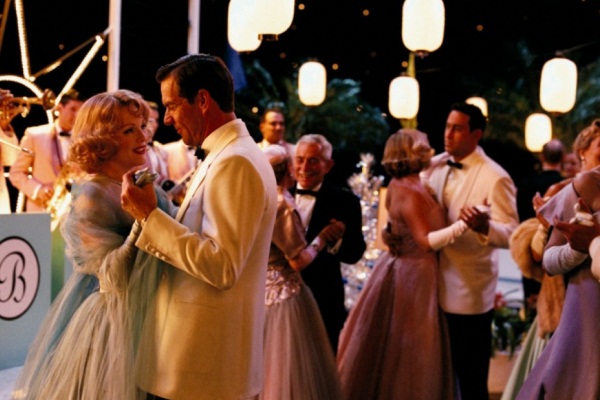
Julianne Moore and Dennis Quaid in Far From Heaven
FRIEDBERG: In a way, it's almost more honest, too.
HAYNES: It's almost more honest. You're not lying. You're being honest. And a viewer always has to do something to make this real for them. And in a weird way, the more you cater to that, the less you're sort of using what is innate to our abilities as spectators, to fill in, to think around—to both think and feel at the same time, I guess, is what has been the goal of some artists and creators. And that's just more true for melodrama than other generic traditions, and it's just one that I continue to go back to in my mind. I just find it to be so interesting and complicated.
SCHWARTZ: I want to ask Sandy, in relation to this idea, what your research was or what your references were. Was it all the movie 1950s, instead of the real 1950s?
POWELL: As Todd was saying just then, about the idea was to make it not look real. I look at that again and I think, My God, it looks really authentic. It looks really authentically like a 1950s film. So in answer to that question, yeah, I did look at a lot of films. I looked at people dressed in films of the period. I did look at things like Sears catalogs and fashion from the period, as well; but really, the main inspiration came from how people looked in films, as opposed to how people really looked on the street.
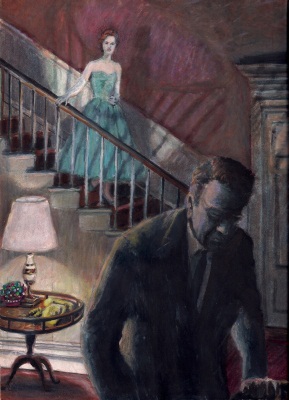
Drawing made by Todd Haynes during pre-production for Far From Heaven
HAYNES: And the weird thing is that I remember getting so many reactions from people when we showed Far From Heaven, who would come up to me and say, (whispers) "That's exactly what it was like in the 1950s. That's my life." (Laughter) And you realize how much popular culture, film, mediate our lives. I love that, and how memory is even affected by popular images.
FRIEDBERG: Todd, didn't you take most of the furniture home with you?
HAYNES: I did. I just recently put it on eBay, the diagonal couch.
FRIEDBERG: Is it still up?
HAYNES: No, it went down right away.
FRIEDBERG: Did you say, "As seen in?"
HAYNES: Well, no, we didn't advertise it that way, but we just told them after they bought it, as a little bonus. ![]()
LATEST ARTICLES
-20140814-173707-thumb3.jpg)
Fighting Words
by Imogen Sara Smith
posted August 12, 2014

Fighting Words, Part 2
by Imogen Sara Smith
posted August 20, 2014

On the Margins: The Fil…
by Andrew Chan
posted August 12, 2014

Robin Williams: A Sense…
by David Schwartz
posted August 12, 2014
 Heaven Sent
Heaven Sent
RELATED CALENDAR ENTRY
June 14–August 19, 2012 Persol Magnificent Obsessions: 30 Stories of Craftsmanship in FilmKEYWORDS
independent cinema | Museum of the Moving Image | Todd Haynes | production designer | Far From Heaven | Mark Friedberg | Sandy Powell | costume designer | melodrama | Douglas Sirk | domesticity | cinematographer | realismTHE AUTHOR
David Schwartz is the Chief Curator at the Museum of the Moving Image. He is also a Visiting Assistant Professor in Cinema Studies at Purchase College.
More articles by David Schwartz
